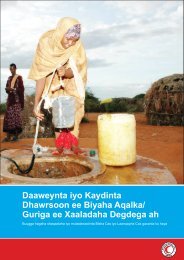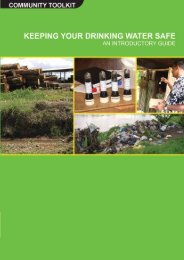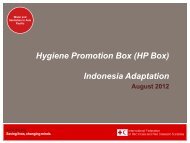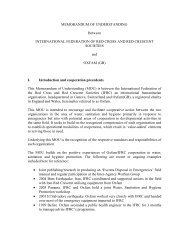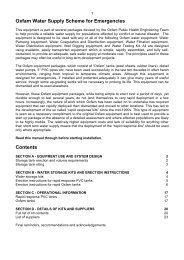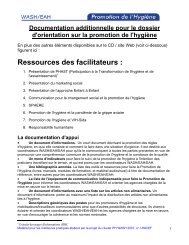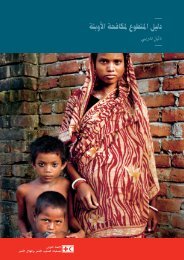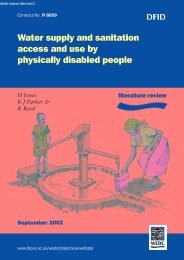covering a number of distinct settlements. In the latter case, there are often twoorganisational layers:• The organisation at the neighborhood or village level organises the participatoryplanning, implementation <strong>and</strong> monitoring;• The organisation at the overall community level manages the overall programme,dealing with such aspects as aggregation or co-ordination of lower level plans,contracting <strong>and</strong> procurement, financial management, <strong>and</strong> accounting for their work tothe contributing male <strong>and</strong> female heads of households.RepresentationCommunity organisations that manage local hygiene promotion must represent thedifferent interest groups <strong>and</strong> capabilities in their neighbourhood, village or largersettlement. Typically, members are women <strong>and</strong> men from the different socio-economic,ethnic <strong>and</strong> religious sections with a good range in ages <strong>and</strong> skills. The groups to whichthey belong choose them for their commitment, trust, time, relevant expertise, traditional<strong>and</strong> modern, in health <strong>and</strong> hygiene.Should organisations for locally managed improvements include political leaders <strong>and</strong>government functionaries? The latter can be of great help but can also dominate decisions<strong>and</strong> monopolise benefits. The solution depends on local conditions. They may berespected <strong>and</strong> represent the interests of all. Otherwise, some kind of checks <strong>and</strong> balanceis needed. Political leaders <strong>and</strong> functionaries have also sometimes become ex-officiomembers, or the organisation that manages the hygiene improvements is a sub-committeewith its own status <strong>and</strong> authority under a local government body.4.4 Useful materials, methods <strong>and</strong> toolsWorking with materialsMaterials <strong>and</strong> equipment for hygiene promotion cost a lot of money. Contrary to what isoften thought, good programmes do not necessarily need to spend most of their budgetson the development <strong>and</strong> production of materials. They decide what they want to achieve<strong>and</strong> how, <strong>and</strong> then decide which techniques, tools <strong>and</strong> training are needed, which of themare already available <strong>and</strong> which gaps need to be filled. Often, there is already quite a bit ofhygiene promotion material available with a range of programmes <strong>and</strong> agencies, but muchof it may be sitting in offices.<strong>Hygiene</strong> promoters do need promotion materials, for their work <strong>and</strong> to give them anelement of status with those they are motivating. Knowing how to work creatively withhygiene promotion <strong>and</strong> education materials <strong>and</strong> having access to materials <strong>and</strong> tools thatare flexible <strong>and</strong> adaptive is more valuable than having a set of st<strong>and</strong>ard booklets <strong>and</strong>posters. Many hygiene promoters who work with local groups also have technical skills thatinclude:• the ability to use locally available natural or low cost materials for producingimplements <strong>and</strong> products for better personal <strong>and</strong> domestic hygiene such as, in rural24 <strong>Hygiene</strong> promotion
areas, slabs <strong>and</strong> sanplats for latrines, wickerwork lining <strong>and</strong> dried bricks for latrine pits,pots for water filters <strong>and</strong> sticks for drying frames;• the ability to facilitate local women <strong>and</strong> men on using natural local materials such assmall pebbles <strong>and</strong> seeds, <strong>and</strong> low cost material such as brown paper <strong>and</strong> felt tippedpens to prepare maps, charts <strong>and</strong> matrices with which they can map out localconditions <strong>and</strong> practices for problem identification, analysis, planning <strong>and</strong> monitoring.Participatory methods <strong>and</strong> toolsParticipatory methods <strong>and</strong> tools are a great help in informed planning <strong>and</strong> decisionmaking.They help not only to plan <strong>and</strong> monitor the implementation of hygieneimprovements, but also to plan <strong>and</strong> monitor performance of management organisations<strong>and</strong> financing systems. Methodologies exist that utilize locally available no cost material,e.g. PRA/PLA <strong>and</strong> MPA or ready-made kits such as PHAST (Appendix 10, 11 <strong>and</strong> 12). Formore on participatory tools go to Appendix 9. Cautions on use <strong>and</strong> costs mentioned aboveare also valid for programmes that promote community managed hygiene improvements.Two examples of participatory techniques <strong>and</strong> tools in community-managed hygienepromotion programmes:• Forming a management organisationIn community-managed hygiene promotion programmes, the presence of a wellfunctioning,capable, representative <strong>and</strong> trusted local organisation to manage theprogramme is crucial to its success. The technique described here helps to form such anorganisation, or to see if an existing organisation could be adapted. In an open meeting,women <strong>and</strong> men discuss the tasks of a water, sanitation <strong>and</strong>/or health <strong>and</strong> hygienecommittee. For each task, they make a small drawing, write a card (if people are allliterate) or choose a life symbol, such as a coin for financial management. They also list,draw or choose symbols for the kind of characteristics <strong>and</strong> expertise committee membersneed to have, e.g. live in the community, have time, have consent of husb<strong>and</strong>. A thirdaspect they consider is which groups the members must represent, e.g. come equally froma red (better-off), blue (middle class) <strong>and</strong> green (poorer) household. The group thinks ofc<strong>and</strong>idates <strong>and</strong> decides which women <strong>and</strong> men meet their own criteria <strong>and</strong> are likely tomake a good committee. The group, or local leaders, approach these c<strong>and</strong>idates <strong>and</strong> acommittee is formed.• Welfare classificationThis tool helps to integrate attention to poverty in the inventory, analysis, planning <strong>and</strong>implementation of local community-managed hygiene promotion programmes. First theparticipants make drawings of a better off, a worse-off <strong>and</strong> an in-between household. Theythen list the characteristics of each group. They also count how many of the households intheir area fall in each group. For this, they distribute the same number of beans as thereare households in their area over the three drawings. They use the information to identifywhich houses belong to which group <strong>and</strong> mark the results on their map. They use theinformation also to decide if the committee is representative. Alternatively, they use theinformation to make a summary table. The three socio-economic groups become the rows.<strong>IRC</strong> <strong>International</strong> <strong>Water</strong> <strong>and</strong> <strong>Sanitation</strong> <strong>Centre</strong> 25
- Page 2: Please note that the TOPs are a web
- Page 7 and 8: 1. Hygiene PromotionWhat do you kno
- Page 9 and 10: 2. Why hygiene promotion matters2.1
- Page 11 and 12: • The costs of inaction can be hi
- Page 13 and 14: 3. Learning from experiences and re
- Page 15 and 16: • Hygiene Improvement Framework (
- Page 17 and 18: groups, and facilitators of partici
- Page 19 and 20: The diagrams are taken from McKee
- Page 21 and 22: • Food, utensils and food prepara
- Page 23 and 24: Guides for developing hygiene promo
- Page 25: • What may prevent this change in
- Page 29 and 30: often not taken seriously and their
- Page 31 and 32: IIIIIIIVVInputsProcOutpEffectiImpae
- Page 33 and 34: over for reasons of hierarchy, e.g.
- Page 35 and 36: 5. Case studiesOn the following pag
- Page 37 and 38: The Project recognises the importan
- Page 39 and 40: almost all cases been exceeded, as
- Page 41 and 42: skin diseases, HIV/AIDS and tubercu
- Page 43 and 44: understanding of the importance of
- Page 45 and 46: councils (JSCs) are associations of
- Page 47 and 48: o through a schools programme, with
- Page 49 and 50: outputs and outcomes are focused mo
- Page 51 and 52: Harvey, Eric, Shadrack Dau, Alana P
- Page 53 and 54: programmes more effective. The obje
- Page 55 and 56: scale. Comparison is on approach, l
- Page 57 and 58: Hygiene Behaviour Network, in Globa
- Page 59 and 60: WHO - World Health Organizationhttp
- Page 61 and 62: Tel: (703) 247-8730Fax: (703) 243-9
- Page 63 and 64: Manila, PhilippinesTel: +632 911-57
- Page 65 and 66: TOP Courses and conferencesCREPA, B
- Page 67 and 68: TOP ReferencesBoot, Marieke T. and
- Page 69 and 70: TOP Quiz on Hygiene PromotionTry it
- Page 71 and 72: Question 4All the interventions wil
- Page 73 and 74: Then you may decide that this paper
- Page 75 and 76: Appendix 1. Hygiene promotion manua
- Page 77 and 78:
2. Target specific audiences.These
- Page 79 and 80:
Appendix 4. WASH facts and figures1
- Page 81 and 82:
Research)18: (IHE Newsletter, Janua
- Page 83 and 84:
Appendix 6. Preventive measuresMeas
- Page 85 and 86:
Appendix 8. Some key objectives for
- Page 87 and 88:
Appendix 9. Participatory tools and
- Page 89 and 90:
Appendix 10. The PHAST approachFor
- Page 91 and 92:
Planning techniques are used to sim
- Page 93 and 94:
While sensitive topics are often be
- Page 95:
About IRCIRC facilitates the sharin



